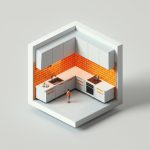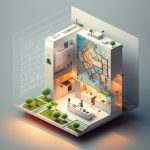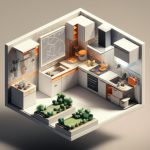Imagine a home that effortlessly adapts to life’s changes, growing with your family and optimizing space. Flexible floor plans offer adaptable designs that enhance home value and suit your lifestyle. For more space-saving ideas, check out these space-saving floor plans. Learn how to design or buy a dynamic space, unlocking the secrets of a future-proof home.
Flexible Floor Plan Options: Maximize Space and Adapt to Evolving Needs
These homes offer adaptability you might not have considered. Let’s explore homes designed to grow with you.
Types of Adaptable Home Layouts for a Modern Lifestyle
Several design approaches cater to homes adjusting to changing needs. Open-concept designs, popular for their spaciousness and flow, minimize walls between rooms. Adaptable rooms easily switch from home offices to guest rooms to playrooms. Modular construction can rearrange sections as lifestyles evolve.
Clever Design Elements for a Flexible Home to Enhance Space
Pocket doors slide into walls, saving space. Folding walls or operable partitions open or close off areas. Built-in furniture maximizes space and functionality, while smart home technology adjusts lighting, temperature, and room configurations.
The Upsides of a Flexible Home: Benefits of Adaptable Design
Space optimization makes even smaller homes feel incredibly spacious. Adaptable floor plans appeal to more buyers, increasing resale value. The most significant benefit is adapting to life’s changes, accommodating growing families and aging parents.
Potential Downsides and Design Considerations for Flexible Spaces
The initial cost of design and construction may be higher. The planning process can be complex, requiring collaboration between architects, builders, and interior designers. Structural limitations might restrict future modifications.
Real-World Examples: Flexible Floor Plans Enhancing Daily Life
A California family converted a spare bedroom into a functional home office. Another adapted their home for aging parents, transforming a room into an accessible living space.
Your Step-by-Step Plan for Designing a Flexible Home
- Consult Professionals: Talk to an architect or interior designer for custom solutions.
- Define Needs: Consider current and future lifestyle needs.
- Explore Options: Research flexible floor plan options.
- Budget Carefully: Incorporate initial construction costs and potential future adaptation costs.
The Future of Flexible Living: Sustainable and Adaptable Homes
Flexible floor plans, prioritizing adaptability and long-term functionality, represent a shift in how we think about homes. Expect more innovation, with technological advancements enhancing customization and convenience. Investing in a flexible home results in a more comfortable, adaptable, and satisfying home life.
How to Calculate Long-Term Cost Savings of Flexible Home Design
Key Takeaways:
- Flexible floor plans reduce the necessity for remodeling.
- Multi-functional spaces enhance space efficiency.
- Long-term savings tend to outweigh higher initial costs.
- Sustainable materials boost savings.
- Careful planning and awareness of local regulations are crucial.
Types of Flexible Floor Plans: Adapting to Your Evolving Needs Seamlessly
Several approaches allow your home to grow and change:
- Open-Concept Layouts: These blend living areas, enhancing natural light.
- Adaptable Rooms: Spaces with multiple potential uses.
- Modular Construction: Expansion potential.
Key Design Elements for Flexibility: Features that Make a Difference
Specific features maximize a flexible home’s potential:
- Space-saving pocket doors.
- Folding walls.
- Custom-designed built-in furniture.
- Automated lighting and climate control.
Advantages of Flexible Design: Long-Term Value Through Adaptability and Savings
- Increased Space Efficiency: Enhances square-footage utilization.
- Improved Resale Value: Appeals to more buyers.
- Adaptability to Changing Needs: Accommodates shifts without costly renovations.
- Reduced Long-Term Costs: Compare the investment to avoided renovation costs.
Potential Drawbacks and Considerations: What to Keep in Mind about Designs
- Higher Initial Costs: Customized features may increase upfront expenses.
- Design Complexities: Requires careful planning.
- Structural Limitations: Some alterations might require permits.
Real-World Examples: Seeing the Benefits in Action on a Flexible Design
One family transformed a spare room into a home office with a folding wall, while another converted a playroom into a game room.
Actionable Steps for Homebuyers and Builders: Making it Happen Practically
- Consult with an Architect: Discuss your needs.
- Prioritize Key Features: Focus on elements optimizing adaptability.
- Budget Wisely: Consider long-term savings when budgeting.
- Stay Informed: Keep abreast of design principles.
Designing Flexible Floor Plans for Multigenerational Living with Ease
Key Takeaways:
- Multigenerational living demands adaptable homes.
- Flexible floor plans offer solutions.
- Key design elements boost adaptability.
- Long-term benefits outweigh higher costs.
- Careful planning is crucial.
Types of Flexible Floor Plans: Adapting to Evolving Needs for Generations
Open-concept designs boost interaction but might not offer the privacy some desire. Adaptable rooms morph to suit varied purposes with multifunctional furniture, while modular construction provides extreme flexibility.
Design Elements: The Building Blocks of Adaptability for your Living Space
Space-saving pocket doors maximize floor areas, while folding walls create or eliminate rooms. Built-in furniture provides clever storage, and smart home technology further enhances customization.
Advantages: Beyond Space for Sustainable Resale Home Value
Flexible floor plans aren’t just about space. They enhance space efficiency, boost resale value, and adapt to lifestyle shifts.
Drawbacks and Considerations: Planning for Success with Practical Design
Initial costs might be steeper, and complex designs require skilled architects and builders. There might be structural limitations, too. However, careful planning mitigates these issues, and provides adaptable space.
Real-World Examples: Inspiration for Your Home and Designing for Life
One family transformed a spare bedroom into a comfortable private suite for aging parents, while another used modular construction to add a wing as their family grew.
Actionable Steps: Designing Your Multipurpose Dream Home
- Consult an architect: Discuss family needs.
- Prioritize key areas: Define essential spaces.
- Explore design elements: Choose features enhancing flexibility.
- Budget carefully: Balance costs and gains.
- Plan for the future: Envision family changes.
Sustainable Materials and Flexible Home Design: Eco-Friendly Adaptable Layouts for Home Value
Key Takeaways:
- The demand for energy-efficient homes is rising.
- Sustainable materials are gaining popularity.
- Water conservation techniques are crucial.
- Indoor air quality is a key benefit.
- Flexible floor plans allow multi-generational uses.
- Lifecycle assessment should consider the materials.
- Regulations affect your design choices.
Types of Flexible Floor Plans that are Easy to Implement
Several options exist:
- Open-concept designs for seamless transitions.
- Adaptable rooms for versatility.
- Modular construction allows for expansion or relocation.
Key Design Elements for Flexibility
Pocket doors maximize space, while folding or movable walls transform rooms instantly. Built-in furniture is cleverly designed to be multi-functional. Smart home technology enhances adaptability.
Advantages of Flexible Floor Space Layouts
A flexible layout optimizes space while resale value increases dramatically as buyers appreciate versatility. Adaptability to your life changes increases a home’s lifespan.
Potential Drawbacks and Considerations
While flexibility offers significant benefits, there are some factors to consider. The initial challenges relate to upfront costs.
- Modern Kitchen Backsplash Ideas To Inspire Your Refresh - December 19, 2025
- Modern Backsplash Ideas: A Guide to Todays Kitchen Trends - December 18, 2025
- Ceramic Kitchen Wall Tiles: Style and Protection for Your Walls - December 17, 2025









